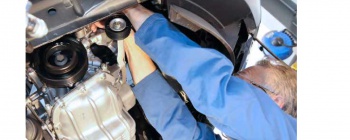
Diagnosing a noisy accessory belt drive
Noise in the accessory belt drive system is most likely not caused by the fan belt itself. The leading causes of so called belt noise are:
- Misalignment of pulleys
- Low belt tension
- A failed or worn component in the drive system
Whenever a vehicle owner complains of unusual noise under the bonnet, it is important to determine under what circumstances it occurs. A solution to a noise problem caused by pulley misalignment is not likely to resolve a slip noise problem that may be caused by insufficient tension, for example.
In any case, a noisy drive indicates a malfunction and appropriate corrective action should be taken to eliminate the problem.
To accurately check for noise symptoms, the system must be fully loaded:
- Air conditioner and fan on full
- Lights on
- Wheels turned 3/4 to the left or right
- Defroster on
Belt noise
A chirping noise that increases in frequency as the engine is revved up can be the result of belt vibration caused by misaligned pulleys – the leading cause of belt noise. As a misaligned multi-ribbed belt span enters the grooves of a pulley, initial contact is made with only one side of the groove. The greater the misalignment angle, the greater the radial sliding length experienced by the belt ribs as the belt seats in the pulley cause frictional vibrations, or chirping.
A high-pitched squealing noise that occurs when pulling away from a stop normally indicates a lack of tension – the second most common cause of belt noise. Without proper tension a belt will slip, the sidewalls will wear smooth and the belt will eventually harden through “heat-ageing”, a process referred to as glazing. The more glazed the belt surface is, the more likely it is to make a squealing noise.
Also, a pebble or other foreign object can become imbedded in the belt, causing a tapping, ticking or grinding noise.
Don't use belt sprays! A spray may quieten the belt as it will cause the belt to slip quietly, but the belt material will absorb this spray and cause the rib surface to dry which means the noise will return. In addition, the spray can cause degradation of the belt compound.
Tensioner noise
A squeaking or rattling noise coming from the tensioner indicates wear on the tensioner’s internal components and impending tensioner failure.
Pulley noise
A grinding noise can also result from damaged bearings in a pulley assembly. Bearing damage can often be detected by continuous grinding noises that increase as an engine’s rpm is increased. To locate the noise: turn off the engine, remove the belt, then hand spin all the pulleys to see if any are hard to turn, feel rough or rattle.
More tips on how to maintain the accessory belt drive system or how to diagnose drive system problems can be found in our secure area- CAR- Technical Information- Gates.


 Click here to open the navigation menu
Click here to open the navigation menu